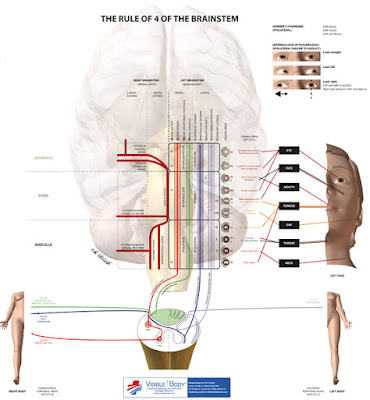When it comes to the neurological clinical exam, I've seen many a student shudder. How to Perform a Neurological exam went over the basics from a structured point of view. Now I'm going to introduce you to some rules of the Neurological Exam, pearls of wisdom, and perhaps most importantly what I like to call the Rule of 5s for Neurological Examination.
The Rule of 5s aims to encompass key considerations of a neurological exam. Though originally inspired by a quick quip from a Doctor on the wards, I've since trawled the internet and saw the pattern emerging everywhere. Thus, the Rule of 5s was born.The Rule of 5s is tailored towards Medical Students and Junior Doctors to layout the basics of neurological examination.
Rule of 5s
So the first part is obviously the entire Neurological Examination. This can be remembered by the Mnemonic below and is split into 5 parts;
CNS MD
- C erebellum and gait
- N erves (CN I-XII)
- S ensory exam
- M otor
- D TR (deep tendon reflexes)
- Wasting
- Deformities/Posture
- Tremors/Tics
- Fasciculations
- Skin Changes
Limb Examinations
Next up on the list are the Limb Examinations. This can be split into upper (e.g. arms) and lower (e.g. legs) limbs depending on what information you are trying to get out of your examination. There are 5 main things you test for on limb examination; Tone, Power, Reflexes, Coordination and Sensation.
Many of which have 5 sub-components.
- Tone (flaccid → normal → increased)
- Power
- 0 = no contraction
- 1 = flicker of contraction (or felt on palpation)
- 2 = movement possible when gravity eliminated
- 3 = active movements against gravity, but not resistance
- 4 = active movements against gravity and resistance
- 5 = normal power
- Reflexes
- 0 = absent
- + = present but reduced
- ++ = normal
- +++ = increased, possibly normal
- ++++ = greatly increase (often associated with clonus)
- Coordination
- Finger–nose test
- Rapid alternating movements
- Rebound
- Heel-shin test
- Foot tapping
- Sensation
- Touch
- Temperature
- Pain
- Vibration
- Proprioception
Finally it is important that we try to localise the area of pathology, whether it be frontal lobe, brain stem or spinal cord. Again there are 5 considerations for pathological localisation, which I've developed the following mnemonic for;
- C erebellar
- L ower Motor Neuron
- U pper Motor Neuron
- E xtra-pyramidal Tract
- S ensory
The Rule of 5s continues on to several other aspects of the neurological exam. Some may be familiar, but I hope there are some new ones as well.
Assessing Pupils
- P upils
- E qual and
- R eactive to
- L ight and
- A ccomodation
- Ataxia (Can be gait or limb specific. Uncoordinated voluntary movements)
- Nystagmus
- Tremor
- Dysathria (slow slurred speech)
- Hypotonia
- Global dysphasia
- Expressive dysphasia
- Receptive dysphasia
- Conductive dysphasia
- Nominal dysphasia
From Oxford Handbook of Clinical Examination & Practical Skills comes another glimpse of the Rule of 5s in action. There are 5 key things to take both on History and do on Examination of the Elderly patient.
History
- Witness histories
- Drug history
- Intercurrent illness
- Cognition and mood disorders
- Functional history
Examination
- Observe
- Think
- Assess cognition
- Gait
- Therapy colleagues
So above is my Rule of 5s. But there are many rules and mnemonics you can put into practice as well.
Brainstem Rules of 4
(Peter Gates’ The Rule of 4 of the Brainstem - Int Med J 2005;263-266 – PDF)
In the rule of 4 there are 4 rules
- There are 4 structures in the ‘midline‘ beginning with M
- There are 4 structures to the ‘side‘ (lateral) beginning with S
- There are 4 cranial nerves in the medulla, 4 in the pons and 4 above the pons (2 in the midbrain)
- The 4 motor nuclei that are in the midline are those that divide equally into 12 except for 1 and 2, that is 3, 4, 6 and 12 (5, 7, 9 and 11 are in the lateral brainstem)
See Lifeinthefastlane.com for the full illustrative guide to the Rule of 4 of the Brainstem.
Head trauma: rapid neuro exam 12 P's (Ernest Boiselier and Sung Kim):
P sychological (mental) status
P upils: size, symmetry, reaction
P aired ocular movememts
P apilloedema
P ressure (BP, increased ICP)
P ulse and rate
P aralysis, Paresis
P yramidal signs
P in prick sensory response
P ee (incontinent)
P atellar relex (and others)
P tosis
Peripheral nervous examination:
"Tall People Run-over Small Children"
"Tall People Run-over Small Children"
T one
P ower
R eflexes
S ensation
C o-ordination/ Clonus
Got you own tips and tricks to tackling the Neuro Exam?
Share them below.







No comments:
Post a Comment